WORLD CLASS COACHING
Tactical Series
Jurgen Klopp
By Alexander Trukan
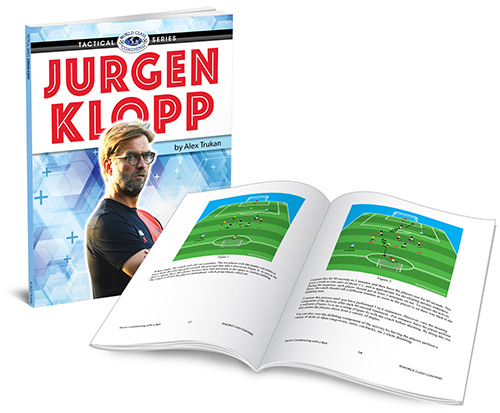
TRANSITION FROM DEFENCE TO ATTACK
The moment when the team wins the ball back is another opportunity to use high energy and intensity. With many teams being very organised defensively and getting compact, it is increasingly difficult to break through using patient positional play. Counter attack though provides a great opportunity to penetrate and create chances as the opposition is disorganised and still in the attacking structure. Especially, when the available players are full of pace, positive attitude and technical excellence it might be tricky to defend against. Klopp’s teams possess players with those characteristics – Mane, Sturridge, Firmino, Lallana as well as Coutinho provide a great base to build your counter attacks from.
The type of counter attack Klopp’s teams use will be heavily dependent on the area where the ball is regained. When defending on the own half, usually one striker is left in front of the ball (Sturridge, Origi). Upon winning possession in the own half, the first priority is to play to the lone striker into space in behind him. In most of the cases, however, the opposition will deny the opportunities to penetrate through in behind their back line. This is why, Liverpool has often played the first counter attacking pass into feet or head of the lone striker whose role was to then combine play with supporting midfielders making forward runs (Firmino, Coutinho, Lallana). This strategy is effective in getting the ball quickly into opposition half and provides time for more players to get forwards and join the attack.
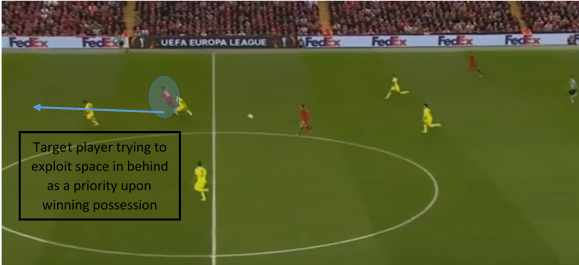
After the arrival of Mane, his pace was more often used in the counter attacks with ball being played into spaces where he has made a run (primary target). He was also used as a supporting player after the lone striker has combined with him (secondary target). Players making forward runs during the counter attack should be looking to use different channels to run into. This will ensure the opposition back line is split, potentially leaving gaps in between them.
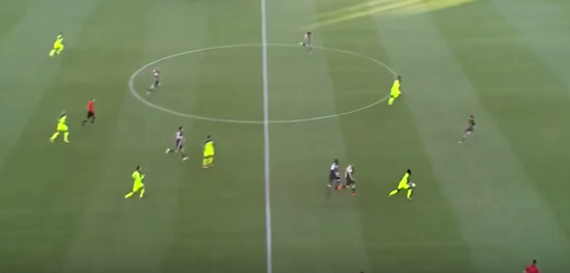
The biggest advantage, however, can be gained by quick reaction time after winning possession. Most importantly, not only reaction of the players on and around the ball, but also players away from it. Those players will be responsible for providing sufficient support as well as finalising play as the ball gets into the opposition half.
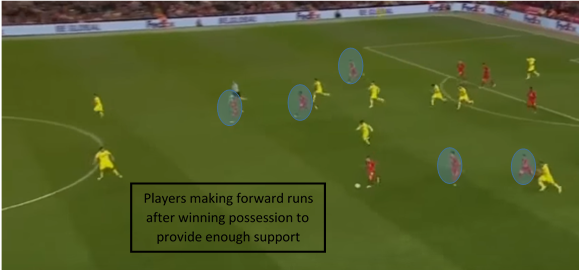
Players receiving the ball from the first player in possession after winning it, should consider finding gaps in between opposition units and operating in available spaces to be able to play forwards. This will help with getting the ball into the final third quicker.
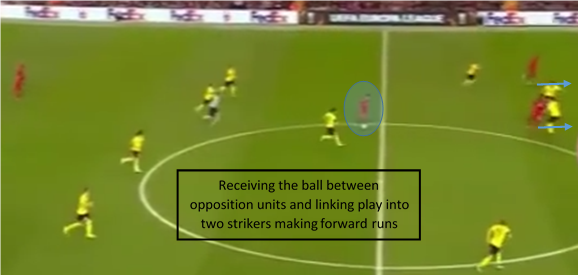
As the ball is in the opposition half, whether after target man laying it off or other player running with it/combining through the thirds, it is crucial to provide support in front of the ball. Strikers making forward runs will not only create opportunities to play in behind but also open up spaces for the player on the ball to run with it. Forward runners (Sturridge, Origi, Mane, Firmino) will often look to start the runs in between opposition centre back and full back and curve it to arrive in different channels and fill the spaces in.
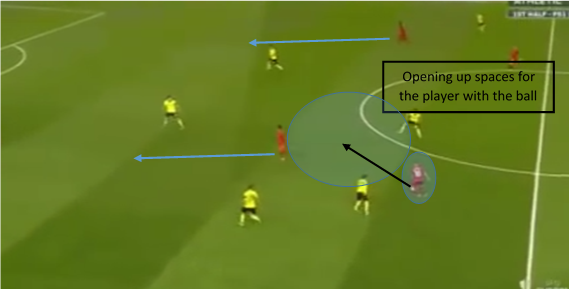
If the space is available for the player on the ball to drive with it, a forward pass might be delayed in order to commit more defenders to pressurise it. This will open even more spaces for the strikers in the final stages of the counter attack. Player responsible for the final pass should have a ‘playmaking’ profile - seeing the options, being great decision maker and technically proficient enough to be able to execute them. At Liverpool, it would be usually Coutinho, Lallana, Wijnaldum and Firmino.
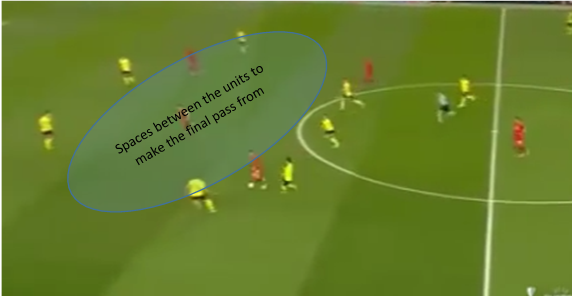
In the first seconds after winning the ball back and starting the counter attack, the team should remain narrow and relative compact. Especially the players in behind the ball should stay close to each other and be organised defensively (even it is an attack). This is crucial to prevent the opposition from using ‘gegenpressing’ strategy and exploiting too early attacking shape after winning the ball. Only after the team gets into controlled possession (usually after 5-6 seconds), it will be looking to provide more width and depth by getting players into attacking positions. This ‘delay’ in adapting an attacking shape, however, should not stop the team from making an effective counter attack. Sufficient amount of players should make forward runs to penetrate and create a scoring chance.
Training practices
Leading in – Possession Game 3v3+2
Set up and organisation
Organise an area of 15 x 25 yards. Divide it further into two halves. Split up a group into two teams of three and add two neutral players which will be positioned on the opposite ends. Prepare a sufficient amount of spare balls next to the target players.
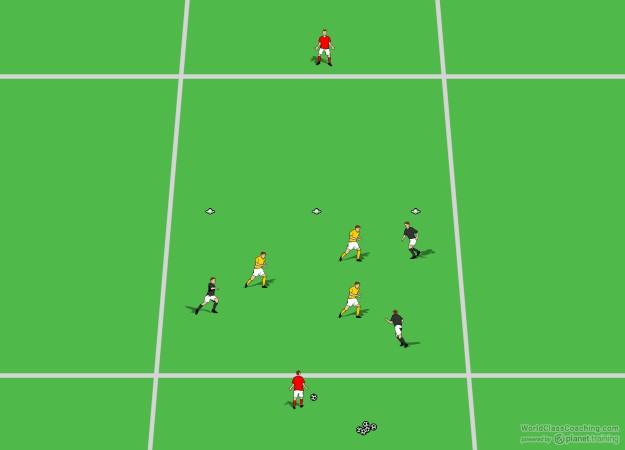
The practice starts with a target player passing the ball into one of the attackers. Both teams have to be positioned in the half closest to the target player starting with a ball. As soon as the ball is played out, the aim for the attacking team is to stay on the ball and try to make 6 passes. Attacking team can use target player on their side to keep possession. As soon as the other team wins the ball, their aim is to transfer the ball to the opposite target player as soon as possible. If this is not successful within 6 seconds, they try to keep possession.
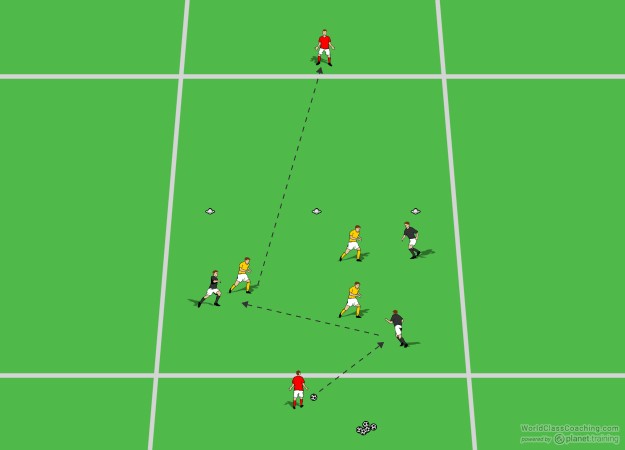
As the ball is transferred to the opposite side, all the players from both teams should move into the other half and remain there. The team that transferred the ball, stay in possession of it and keeps possession.
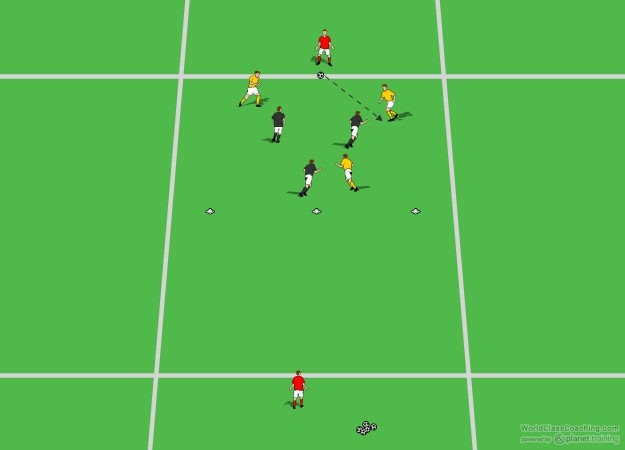
This practice can be adapted to suit different numbers – 4v4+2, 5v5+2 or even 6v6+2. It can be also conditioned to include different ways of transferring the ball into opposition half – run through the line, direct pass or combining through the thirds. All of these link to different ways of counter attacking used in a bigger picture.
Main part – Small Sided Game 8v8
Set up and organisation
Organise a pitch of approximately 60 x 35 yards. Divide it further into two halves. Place two full size goals on the opposite ends. Split the group into two teams of 8 (7+GK). Defending team (yellow) defends the goal closer to the half way line and has a freedom of players’ movement between the halves. Counter attacking team (black) defends the opposite goal and has to have 6 players on the own half and 1 player on the opposition half when out of possession. When in possession, the black team has a freedom of movement between the halves.
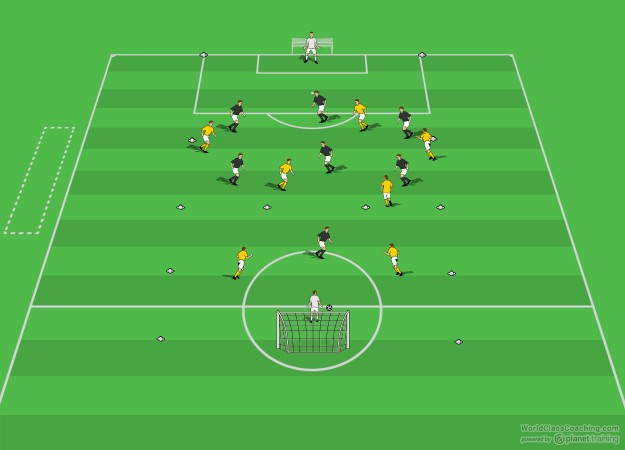
The game starts with a yellow team goalkeeper who plays the ball out into one of his teammates. The team then tries to build up into attacking half and score. Because the black team has 6 players on the own half and most likely will be overloaded, a lot of possession turn overs will happen in those areas.
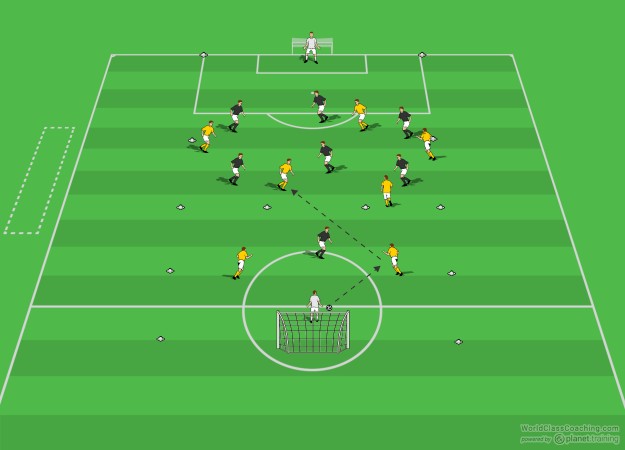
As soon as the black team wins the ball, they will be looking to counter attack as soon as possible. There will be a player available on the opposition half to use to get the ball forwards quickly. As soon as the ball is won, players should be looking to make forward runs and support the striker. There are no corners in this game, after a goal is scored or the ball goes out behind the goal, it is restarted from the goalkeeper of the yellow team. Throw ins apply.
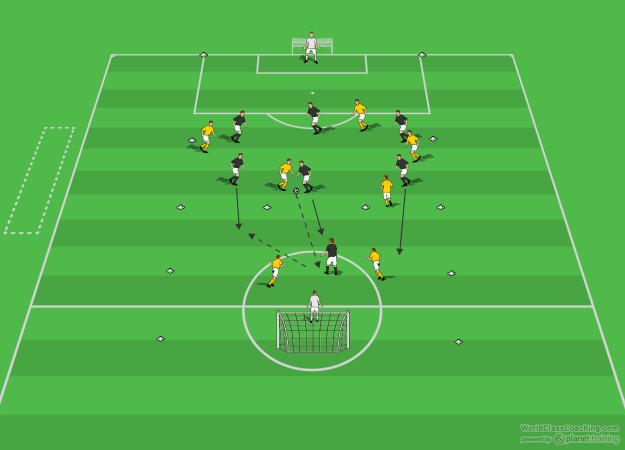
This practice can be further progressed into 9v9 Small Sided Game and then Phase of Play using more players and larger spaces. Counter attacking practices require large physical load and therefore work to rest ratio should be considered carefully.
TOP 10 FOR HIGH INTENSITY SESSIONS
1. Make sure the session is well planned and organised
2. Prepare used areas and put down all the cones before the start of the session – minimise waiting time
3. Ensure there is a sufficient amount of spare balls ready to use in case the other one goes out
4. Use practices which involve transitions
5. Develop players’ motivation – there are many ways of doing it but allowing players to know the reasons for certain practice is a good start!
6. Make sure all the players are involved and not standing around
7. Be enthusiastic and switched on – energise players!
8. Ensure competition between players – i.e. keep the scores, use scenarios, set time limits
9. Allow time for breaks and active recovery to then come back for another chunk of sharp work
10. Make quick (30 sec. max) interventions in natural breaks (i.e. during recovery) – maximise ball rolling time!
AUTHOR
Alexander Trukan
Nottingham Forest Academy Coach
Manchester City FC Development Coach
The FA Coach Mentor
The FA Development Coach at St’George’s Park
UEFA and Youth Award Licences
Author of articles for WORLD CLASS COACHING


